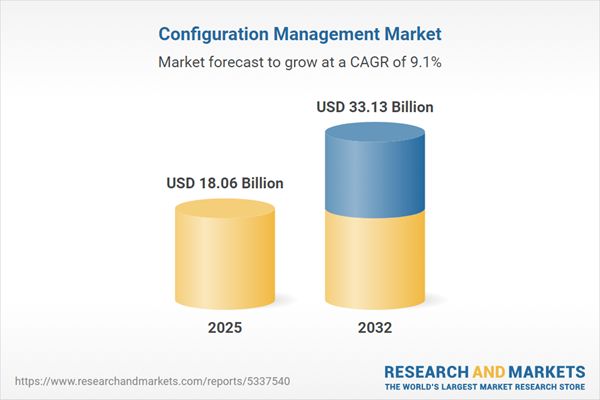Speak directly to the analyst to clarify any post sales queries you may have.
Configuration management is a strategic enabler for organizations seeking to align evolving IT environments with business objectives while maintaining speed, compliance, and resilience. As enterprises undertake digital transformation, robust configuration management solutions play a critical role in supporting modernization and reducing operational risk.
Market Snapshot: Configuration Management Market Size and Growth
The global configuration management market reached USD 16.54 billion in 2024 and is forecast to increase to USD 18.06 billion in 2025, with a projected compound annual growth rate of 9.06% through 2032. This growth trajectory is driven by the accelerating digital transformation of enterprises, a shift toward cloud-native platforms, and the broad adoption of DevOps practices. As organizations evolve from traditional systems to hybrid environments, regulatory compliance takes on increased importance. Vendors in this space are prioritizing automation, advanced security, and integrated solutions so enterprises can address the needs of distributed, multi-cloud operations while maintaining high performance.
Scope & Segmentation: Configuration Management Market Overview
- Component: Consulting services, integration support, modular configuration platforms, and advanced software allow organizations to automate workflows and navigate distinct phases of digital and IT modernization.
- Deployment Mode: Cloud-based models deliver rapid scalability and modernization for organizations, while on-premises solutions meet compliance needs and support legacy infrastructure critical to regulated sectors and industries with high data sensitivity.
- End User: Finance, healthcare, IT and telecom, manufacturing, and retail sectors each rely on configuration management to enhance compliance, improve security, and create resilient IT structures for sector-specific challenges.
- Distribution Channel: Direct sales, channel partnerships, and distributor networks provide widespread market access, enabling both global deployment and local solution customization in regions with unique requirements.
- Application: Configuration management supports IT efficiency, system reliability, proactive risk management, IT asset oversight, and fortified security, allowing for seamless business operations and steady technological advancement.
- Geographic Coverage: The Americas, Europe, Middle East, Africa, and Asia-Pacific regions each reflect distinct compliance frameworks and technology adoption cycles. Regulatory agendas in leading markets such as the United States, United Kingdom, Germany, and China shape worldwide adoption patterns and deployment strategies for configuration management.
- Leading Companies: Microsoft Corporation, IBM, Broadcom Inc., ServiceNow, VMware Inc., Micro Focus International, Cisco Systems Inc., Atlassian, GitLab Inc., Hewlett Packard Enterprise, Intel Corporation, and Oracle Corporation are at the forefront of platform development and the standardization of industry best practices.
Key Takeaways: Strategic Insights for Senior Decision-Makers
- Enterprises leverage automated configuration management and artificial intelligence to boost operational agility, enabling IT teams to adapt as strategic objectives shift.
- Adopting infrastructure-as-code and policy-centric frameworks strengthens organizational governance, embedding compliance and cybersecurity safeguards across operational processes.
- Modern configuration management solutions simplify new service integration and digital adoption by lowering complexity, reducing operational risk, and supporting business transformation.
- Real-time analytics and advanced reporting tools align IT management with organizational goals, providing actionable data that drive strategic outcomes.
- Scalable platforms are essential in regulated sectors, supporting compliance efforts and ensuring business continuity during regulatory realignment and risk mitigation planning.
- Collaboration among vendors, combined with the contributions of cloud-native and open-source initiatives, supports interoperability and operational flexibility for distributed, multi-cloud environments.
Configuration Management Market: Tariff Impact on Supply Chain and Cost Pressures
- Regional tariff policy changes prompt organizations to strengthen resilience by diversifying supplier networks, which helps reduce vulnerabilities from potential disruptions.
- As organizations adopt cloud and hybrid infrastructure, sourcing options expand, lowering reliance on individual hardware suppliers and supporting more efficient IT budgeting in fluctuating market conditions.
- Enhanced oversight of assets and suppliers supports greater fiscal control and business resilience, empowering companies to respond proactively to shifts in global supply dynamics.
Methodology & Data Sources
This analysis comes from thorough secondary research, structured expert interviews, and targeted market surveys. All findings are validated with vendor data and objective analysis to provide dependable and relevant information for technology leaders and senior stakeholders.
Configuration Management Market: Why This Report Matters
- Strategic insights equip senior decision-makers to confidently integrate modernization and automation into IT planning, ensuring business objectives remain aligned with technology strategy.
- Clear segmentation and detailed competitor analysis help guide precise investments and support risk mitigation in pursuit of organizational growth goals.
- Procurement and IT teams gain actionable tools for streamlining supply chains, maintaining compliance, and enabling agile infrastructure deployment across various business environments.
Conclusion
Configuring IT environments with agility, security, and resilience is essential for effective business operations. Equipped with market insights, decision-makers can advance modernization and manage complexity in rapidly evolving digital contexts.
Additional Product Information:
- Purchase of this report includes 1 year online access with quarterly updates.
- This report can be updated on request. Please contact our Customer Experience team using the Ask a Question widget on our website.
Table of Contents
3. Executive Summary
4. Market Overview
7. Cumulative Impact of Artificial Intelligence 2025
Companies Mentioned
The companies profiled in this Configuration Management market report include:- Microsoft Corporation
- International Business Machines Corporation
- Broadcom Inc.
- ServiceNow, Inc.
- VMware, Inc.
- Micro Focus International plc
- Cisco Systems, Inc.
- Atlassian Corporation Plc
- GitLab Inc.
- Hewlett Packard Enterprise Development LP
- Intel Corporation
- Oracle Corporation
Table Information
| Report Attribute | Details |
|---|---|
| No. of Pages | 187 |
| Published | October 2025 |
| Forecast Period | 2025 - 2032 |
| Estimated Market Value ( USD | $ 18.06 Billion |
| Forecasted Market Value ( USD | $ 33.13 Billion |
| Compound Annual Growth Rate | 9.0% |
| Regions Covered | Global |
| No. of Companies Mentioned | 13 |









